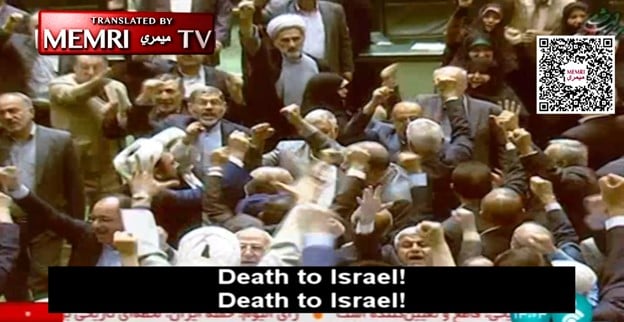 Irański „parlament” Majlis raduje się w niedzielę 14 kwietnia 2024r. z powodu ataku na Izrael. (Źródło zdjęcia: zrzut z ekranu wideo.)
Irański „parlament” Majlis raduje się w niedzielę 14 kwietnia 2024r. z powodu ataku na Izrael. (Źródło zdjęcia: zrzut z ekranu wideo.)
 Prawdziwy obraz wojny na Bliskim Wschodzie widać teraz w pełnym świetle
Prawdziwy obraz wojny na Bliskim Wschodzie widać teraz w pełnym świetle
Matti Freidman
Tłumaczenie: Małgorzata Koraszewska
Jak błyskawica zapalająca się w ciemnym pokoju, atak Iranu na Izrael w końcu dał światu coś cennego: wgląd w prawdziwe intencje Teheranu.
.
Przez ostatnie sześć miesięcy, od czasu dokonanej przez Hamas masakry z 7 października, siły ideologiczne sprzymierzone przeciwko Izraelowi robiły wszystko, co w ich mocy, aby wyglądało to na wojnę, w której są dwie strony, a tymi stronami są izraelscy żołnierze i palestyńscy cywile. Ta kampania informacyjna jest tak samo ważna dla wrogów Izraela jak wojna fizyczna, ponieważ osłabia zachodnie poparcie, którego Izrael potrzebuje, aby wygrać i przetrwać. Jego udana realizacja przekształciła wojnę dżihadystów przeciwko enklawie mniejszości żydowskiej na Bliskim Wschodzie w opowieść o żydowskim ucisku, a nawet jakimś “ludobójstwie” Palestyńczyków, historię, która stała się przedmiotem coraz bardziej obłąkanego dyskursu na liberalnym Zachodzie.
Ideologicznymi antagonistami Izraela w dzisiejszych czasach są niestety nie tylko Hamas i Iran, ale także zachodnia prasa i środowisko akademickie, a także świat organizacji pozarządowych, który dostarcza wiele pożywki dla zachodnich narracji. (Wystarczy spojrzeć na relację Olivii Reingold z konferencji aktywistów antywojennych w Chicago, gdy rozeszła się wiadomość o ataku). To jest główny powód, dla którego tak wielu obserwatorów ma trudności ze zrozumieniem, co się dzieje. Podobnie jak w poprzednich rundach walk w Gazie, taktyka Hamasu polegająca na ukrywaniu bojowników i broni za cywilami oraz karmieniu łatwowiernej prasy fałszywymi liczbami ofiar i wybiórczymi zdjęciami, wytworzyła przytłaczające wrażenie niepotrzebnej tragedii cywilów – a tym samym oburzenie mające na celu związanie rąk Izraelowi, a także wywołanie wrogości wobec Żydów na całym świecie.
Ta w dużej mierze fikcyjna narracja jest kontynuacją wieloletnich doniesień prasowych, które twierdzą uparcie, że ta historia jest “konfliktem izraelsko-palestyńskim”, ramą, która ustawia sześć milionów Żydów w regionie jako potężną większość, a setki milionów Arabów i muzułmanów w regionie, z których ogromna większość nie jest Palestyńczykami, jako oblężoną mniejszość.
Prawda jest taka, że nie ma konfliktu “izraelsko-palestyńskiego”, który istniałby w izolacji. Jest wojna arabsko-muzułmańska z Żydami, która trwa od około stu lat, w której większość walczących po stronie arabskiej nie jest Palestyńczykami, a niektóre żydowskie ofiary nie były Izraelczykami (jak na przykład Argentyńczycy zabici przez irańskich terrorystów w centrum społeczności żydowskiej w 1994 r. lub masy Żydów zmuszone do opuszczenia swoich domów w świecie islamskim po założeniu Izraela). Obecnie istotny konflikt toczy się między sojuszem kierowanym przez szyickich duchownych Islamskiej Republiki Iranu przeciwko państwom w orbicie amerykańskiej, w większości sunnickim, takim jak Jordania i Arabia Saudyjska, a jedno z tych państw jest żydowskie.
Noc z soboty na niedzielę powinna wyjaśnić tym, którzy wciąż mają wątpliwości, że Gaza jest tylko częścią szerszej historii rosnącej potęgi Iranu i coraz większego okrążenia Izraela przez jego siły. Dopiero w tym kontekście zachowanie Izraela i jego przeciwników staje się łatwiejsze do zrozumienia.
Hamas i Islamski Dżihad w Gazie są jednym z ogniw irańskiego okrążenia. Huti w Jemenie, którzy nękają statki handlowe i ostrzeliwują izraelski port w Ejlacie na południu Izraela, są kolejnym ogniwem. Wspierane przez Iran milicje w Iraku stanowią trzecie ogniwo. Irańskie siły zbrojne i ich poplecznicy w Syrii, w tym dowódcy Gwardii Rewolucyjnej zabici w niedawnym izraelskim nalocie na konsulat w Damaszku, są czwartym. (Uderzenie z 1 kwietnia, które nastąpiło po miesiącach ataków na Izrael przez pełnomocników kierowanych i uzbrojonych przez Korpus Strażników Islamskiej Rewolucji, jest zazwyczaj przedstawiany przez przeciwników Izraela jako niesprowokowany atak na placówkę dyplomatyczną, tak jakby dowódcy organizacji terrorystycznej byli attaché kulturalnymi, którzy przybyli, by uczestniczyć w koncercie dobrej woli). Libański Hezbollah, którego bombardowania od 7 października wyludniły znaczną połać północnego Izraela, jest piąty. Jeśli spojrzysz na mapę, zobaczysz, że Iran metodycznie instalował swoich pełnomocników, którzy mogą uderzyć na Izrael z prawie każdego kierunku z wyjątkiem zachodu, gdzie graniczymy z Morzem Śródziemnym.
Znaczenie niedzielnego ostrzału polegało na tym, że po raz pierwszy pełny sojusz irański dał nam praktyczną demonstrację swojego zakresu, orkiestracji i intencji. Radykalne odejście od dotychczasowej praktyki polegało na tym, że sama Republika Islamska po raz pierwszy odważyła się zaatakować bezpośrednio. Gdybyście obserwowali to z kosmosu, prawdopodobnie zobaczylibyście linie tego nowego Bliskiego Wschodu wyryte na pomarańczowo i czerwono na mapie regionu. Być może zauważyliście również drugą część tej historii, czyli udaną obronę zorganizowaną nie tylko przez Izrael, ale także przez USA i Wielką Brytanię, a także przez Jordanię i, jak się wydaje, przez Arabię Saudyjską – mile widziany rozwój wydarzeń, trudny do wyobrażenia kilka lat temu i wciąż zagadkowy dla zachodniego obserwatora karmionego opowieściami o “konflikcie izraelsko-palestyńskim”.
To, czy ten atak był mistrzowskim posunięciem, czy błędem Iranu, w końcu stanie się jasne. Ale już teraz jest oczywiste, że wyświadczyli obserwatorom przysługę, wychodząc z cienia, aby rozwiać wszelkie wątpliwości co do tego, czym jest ta wojna i kto w niej walczy.
Matti Friedman – Były wieloletni dziennikarz Associated Press, pracował jako reporter w Libanie, Maroko, Egipcie, Moskwie i w Waszyngtonie. Informował o konfliktach na Kaukazie i w Izraelu. w 2014 roku wydał książkę The Aleppo Codex, która szybko stała się bestsellerem. Mieszka w Jerozolimie. Jego artykuł pod tytułem „Były korespondent Associated Press wyjaśnia” z 2014 roku, ujawniający metody pracy dziennikarzy zachodnich w Jerozolimie wywołał burzę, ale sytuacji w żaden sposób nie zmienił.
Zawartość publikowanych artykułów i materiałów nie reprezentuje poglądów ani opinii Reunion’68,
ani też webmastera Blogu Reunion’68, chyba ze jest to wyraźnie zaznaczone.
Twoje uwagi, linki, własne artykuły lub wiadomości prześlij na adres:
webmaster@reunion68.com




